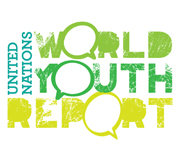
The report is based on the experiences of young people affected by migration and relates the stories of individuals as they move to new lands. About half of the young international migrants are women and girls, and 60 per cent of young international migrants live in developing countries. The report primarily focuses on the experiences of international migrants, but notes that many young people are internal migrants who move within their home countries.
The report outlines the global situation of young migrants by highlighting some of the concerns, challenges and successes experienced by young migrants as told in their voices taken from a series of online consultations and surveys organized by UN DESA.
“As a young, unmarried couple, we sought stability and the chance to start a life together,” Tome and Elizabete, young Portuguese migrants living in France, said. “We were searching for a better life, and there came an opportunity to migrate.”
Young migrants are a diverse group. Their social, economic and educational backgrounds, how they migrate, and their motivation for leaving all influence the scope, scale and type of migration they experience. The struggles and opportunities young migrants face often differ according to the type of migration, such as regular versus irregular or voluntary versus forced.
Voluntary migration for work, study or family reasons is more common than forced migration. The legal status of young migrants varies as they travel through transit and destination countries. Some travel as documented migrants, moving through legal channels or staying in other countries with the required paperwork. However, others are undocumented migrants who may lack the necessary legal authorization to enter, stay or work in a transit or destination country, or have overstayed the allowed time in their country of destination and are thus in an irregular situation.
“Financial dependence among young people significantly affects their migration decision,” Laz, a Nigerian migrant living in the United States, said. “Some young people make the choice of using a cheaper but illegal route to move to another country when they are faced with the paucity of funds.”
The reasons young migrants moved varied widely in accounts noted in the report with some positive, such as for educational and job opportunities, and some negative, such as due to conflict, coercion or persecution.
“Persecution based on my sexual orientation and gender identity was a deciding factor for me as a transgender woman,” Liaam, a female migrant living in the United States, said. “My country of origin did not provide the guarantees necessary to protect my life.”
The report examines the motivating factors behind young people’s migration decisions, the importance of information in preparing for and reducing the risks associated with migration, and the cost of migration and how it influences the choice of migration routes.
Better information needed
According to the report, many young people are excited at the prospect of leaving home, but the period leading up to their departure presents many challenges. One of the challenges cited most often by participants in the report’s online consultations and survey was the difficulty youth faced in obtaining accurate information about their intended destination.
“The first challenge young migrants need to face before starting their journey is to be prepared to adapt to a new culture, within a different environment from what they were used to, and to continually be informed about their rights and obligations as ‘newcomers,’” Raluca, a 26-year-old female migrant from Romania living in Belgium, said.
The report also gives a comprehensive account of the challenges faced by the young migrants in finding housing, securing employment, accessing health care services, and adapting to life in a new location.
“It wasn’t easy, but we did it,” Itzel, a young migrant from Mexico living in Spain, said. “The challenges were simple: find a new home in a new city and understand the social construct of that city.”
The report suggests that youth engagement in migration as well as in policy and programming should improve the situation of young migrants. An online consultation participant suggested utilizing technology to provide better information.
“The world is at our fingertips,” Rima, a young migrant living in the United Arab Emirates, said. “If each country’s ministry of interior produced a smartphone app or website for potential youth migrants, this could simplify the process and ensure that fewer people fell prey to untrustworthy travel agents.”
Interpreting young migrant stories through art
Seeking to bring additional meaning to the findings of the online consultations and survey, UN DESA invited young people to contribute artwork for inclusion in the report. The submissions highlighted the positive and negative effects of internal and international migration on young people, migrant families, and their nations as a whole.
To present some of the stories and artwork from the report, UN DESA partnered with Emmy Award-winning filmmaker Lisa Russell to curate and moderate the launch event. Along with a formal presentation of the report, the launch event today featured young people retelling diverse migration stories through theatre, dance, poetry and music.
The World Youth Report is a biennial flagship publication of UN DESA. The World Youth Report aims to give young people a voice and empower them to contribute to the development of strategies that give young people everywhere a real opportunity to become independent and responsible global citizens.
